
DOT
Polkadot-pris
$4,7790
+$0,16600
(+3,59 %)
Prisändring från 00.00 UTC fram till nu

Hur känner du för DOT idag?
Dela dina känslor här genom att göra tummen upp om du känner dig bullish för coin eller tummen ner om du känner dig bearish.
Rösta för att visa resultat
Friskrivningsklausul
Det sociala innehållet på den här sidan ("Innehållet"), inklusive men inte begränsat till tweets och statistik som tillhandahålls av LunarCrush, kommer från tredje part och tillhandahålls " i befintligt skick" och endast i informationssyfte. OKX garanterar inte innehållets kvalitet eller sanningshalt, och innehållet representerar inte OKX:s åsikter. Det är inte avsett att tillhandahålla (i) investeringsrådgivning eller -rekommendationer; (ii) ett erbjudande eller en uppmaning att köpa, sälja eller inneha digitala tillgångar; eller (iii) finansiell, redovisnings-, juridisk eller skatterådgivning. Digitala tillgångar, inklusive stabil kryptovaluta och NFT:er, innebär en hög grad av risk och kan fluktuera kraftigt. Priset och prestandan för den digitala tillgången är inte garanterade och kan ändras utan föregående meddelande.<br>OKX tillhandahåller inga rekommendationer om investeringar eller tillgångar. Du bör noga överväga om handel eller innehav av digitala tillgångar är lämpligt för dig, med tanke på din ekonomiska situation. Vänligen rådfråga en juridisk-/skatte-/investeringsrådgivare för frågor om just dina specifika omständigheter. För mer information, vänligen se våra <a href="/help/terms-of-service">Användarvillkor</a> och <a href="/help/risk-compliance-disclosure">Riskvarning</a>. Genom att använda tredjepartswebbplatsen (”third-party website/TPW”) godkänner du att all användning av TPW kommer att omfattas av och regleras av villkoren i TPW. Om inte annat uttryckligen anges skriftligen är OKX och dess dotterbolag ( OKX ) inte på något sätt associerade med ägaren eller operatören av TPW. Du samtycker till att OKX inte är ansvarigt eller skyldigt för någon förlust, skada eller andra konsekvenser som uppstår på grund av din användning av TPW. Vänligen observera om att användning av en TPW kan resultera i förlust eller minskning av dina tillgångar. Produkten kanske inte är tillgänglig i alla jurisdiktioner.
Polkadot marknadsinfo
Marknadsvärde
Marknadsvärde beräknas genom att multiplicera det cirkulerande utbudet av ett coin med dess senaste pris.
Börsvärde = Cirkulerande utbud × Senaste pris
Börsvärde = Cirkulerande utbud × Senaste pris
Cirkulerande utbud
Totalt belopp för ett coin som är allmänt tillgängligt på marknaden.
Marknadsvärde-rankning
Ett coins rankning i termer av marknadsvärde.
Högsta någonsin
Högsta pris ett coin har nått i sin handelshistorik.
Lägsta någonsin
Lägsta pris ett coin har nått i sin handelshistorik.
Marknadsvärde
$7,27B
Cirkulerande utbud
1 522 267 060 DOT
100,00 % av
1 522 267 060 DOT
Marknadsvärde-rankning
--
Granskningar

Senaste granskningen: 1 juni 2020
Högsta priset under 24 tim
$4,8000
Lägsta priset under 24 tim
$4,5600
Högsta någonsin
$55,0940
−91,33 % (-$50,3150)
Senast uppdaterad: 4 nov. 2021
Lägsta någonsin
$2,5000
+91,16 % (+$2,2790)
Senast uppdaterad: 22 aug. 2020
Polkadot-flödet
Följande innehåll är hämtat från .

xero 🎮
Kryptospel stängs av Web3 Gaming är död
Vänta, vad är det här då:
1. NFL Rivals gör bra ifrån sig i appbutiker med 4,5 av 5 i recensionsbetyg och miljontals nedladdningar på @Polkadot tech.
2. Maple Story lanserades på @avax och växande försäljning och hävdade en försäljning på $5000 av en karaktär.
3. Det @playmythical teamet som byggde NFL Rivals bygger Pudgy Penguins och FIFA Rivals, som båda också lanseras på Mythos-kedjan som är Polkadot-teknik.
4. @Somnia_Network byggt ut ett Minecraft-liknande spel som heter Chunked som är 100% onchain och sparar varje drag och har en AI-speltillverkare på gång plus många fler spel som lanseras på deras kedja.
5. @KaiaChain har monstertillväxt för sina spel efter lanseringen på Line som har en miljard plus installationer, hävdar miljontals betalningsplånböcker och fler aktiva användare än TON.
Dessa är alla kryptospel med en ljus framtid.
Vinsterna sker om du ser dig omkring, och precis som web2-spelmarknaden är det många som inte gör det varje år.
Men web3-spel kommer tillbaka för omgång 2 2025 och 2026.
Och om du är dålig på att spela spel kan du gapa om dem för potentiella belöningar för dem på Kaito 😂
Låt oss gäspa lite positivitet tillbaka in i tidslinjen 🫡
Visa original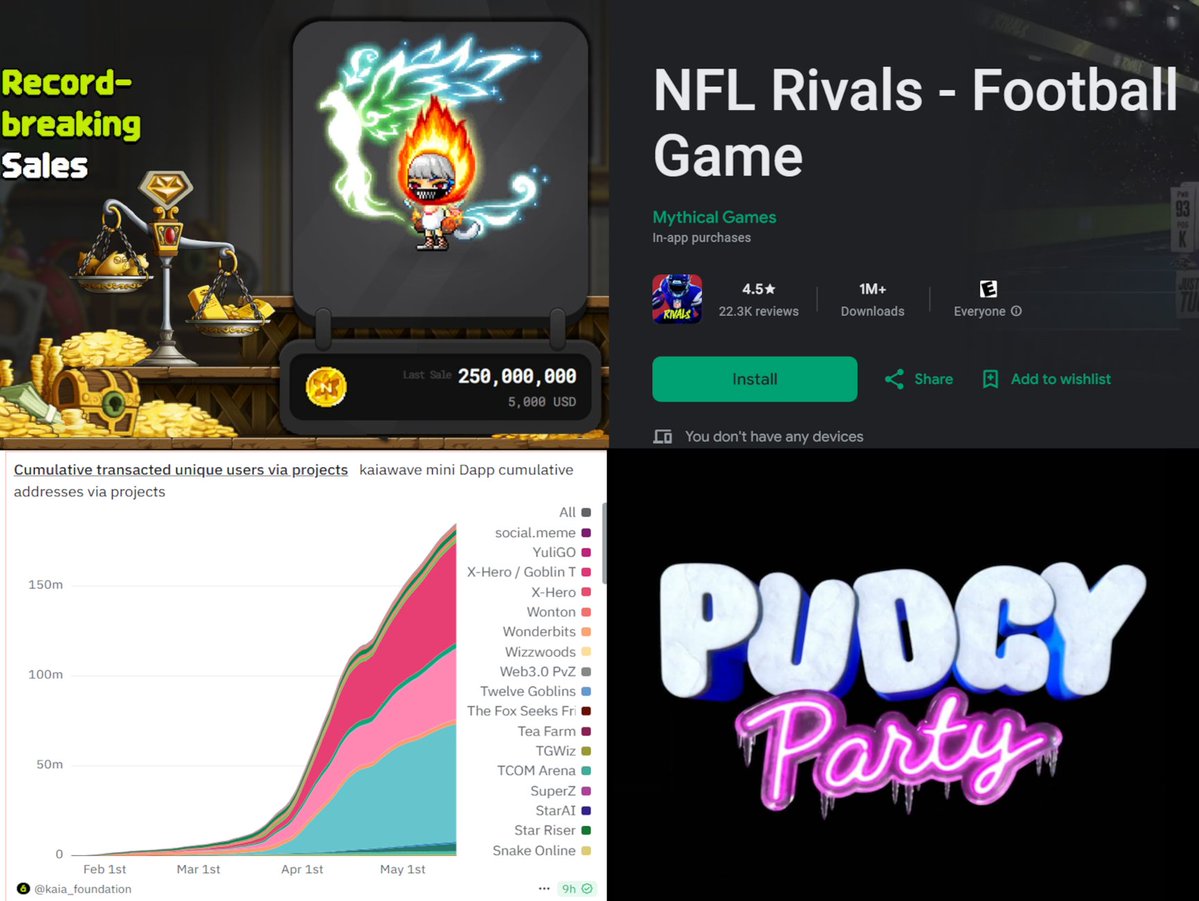
21,97 tn
54

Hades Web3
Fyra projekt kommer att betala dig för att twittra om dem.
> @infinex (6 miljoner dollar allokerade till topp 500)
> @SeiNetwork ($26.5k per månad till topp 50)
> @Polkadot ($100k per månad till topp 50)
> @dYdX ($50k varje månad till topp 100)
Även små kreatörer kan tjäna $1-3k varje månad genom att gläfsa om dessa projekt. Kaito.
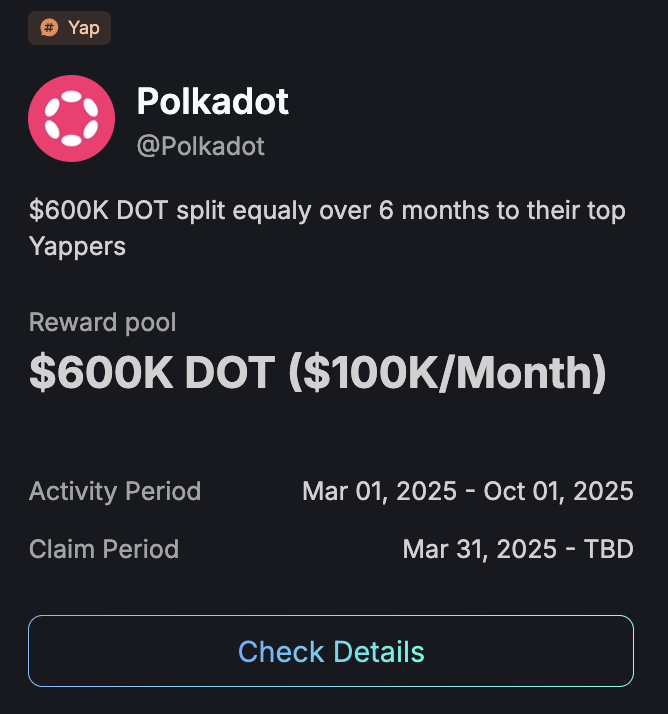

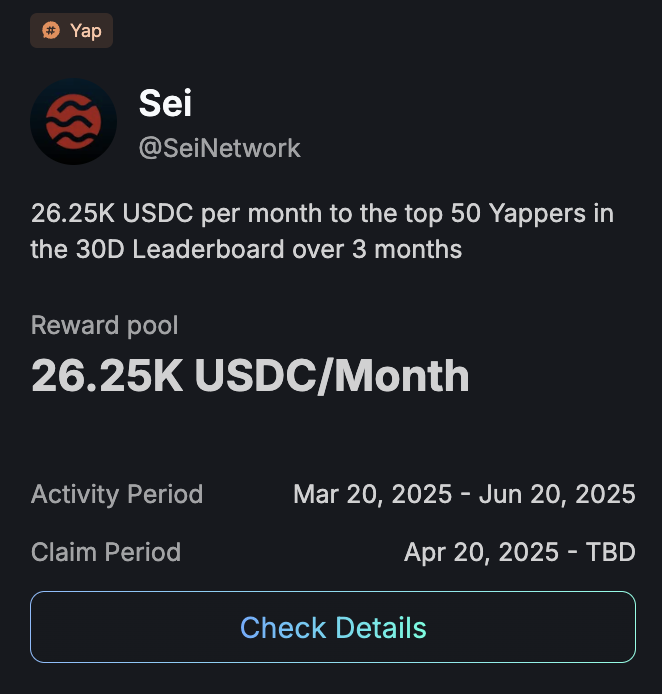
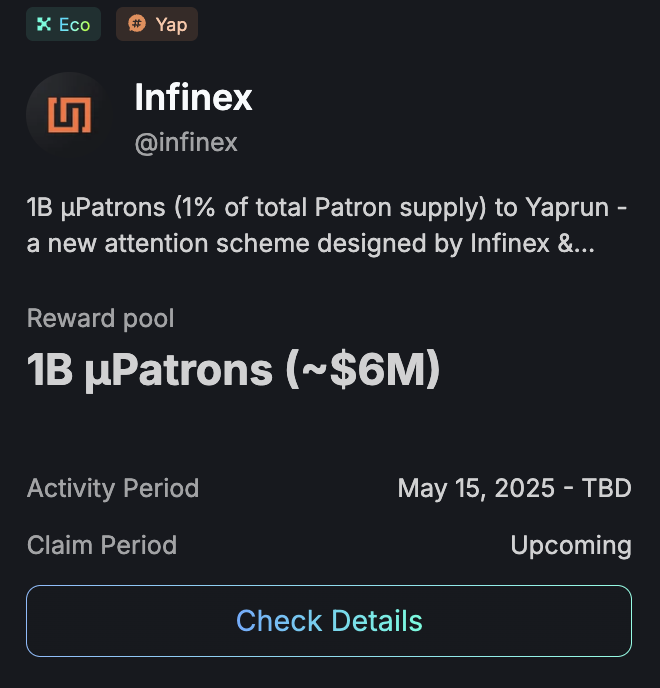

Hades Web3
Enligt min mening är @KaitoAI gläfsande en måste-göra-aktivitet i denna InfoFi-cykel:
När jag började tjänade jag 0 Yap eftersom jag inte kände till några viktiga punkter som förändrade allt.
Här är varför och hur du fixar det (och förbereder dig för sändningen av säsong 2 airdrop).
Du blir belönad för:
> stolpar med hög signal
> Interagera med smarta människor
> Bidra till riktiga Web3-konversationer
Varje vecka belönar Kaito de bästa bidragsgivarna över hela Web3 X-tidslinjen.
De mäter vem du pratar med, vad du säger och hur du för samtalet framåt.
Det är en airdrop på sociala lager baserad på Mindshare. Kaito Algo tittar på vem som interagerar, inte hur många.
Det handlar om inflytande, inte om att påverka jordbruket.
Mindshare = hur mycket du betyder i on-chain-konversationen.
Prata med personer som är aktiva inom InfoFi. Få engagemang från människor som bygger, investerar eller spårar riktig alfa.
Nu fokuserar jag på dessa projekt:
> @MagicNewton
> @TheoriqAI
> @SuccinctLabs
Uppmärksamhetsekonomin tokeniseras i realtid.
Dags att gäspa smart.

13,65 tn
41

snax.eth (😋,🏴☠️)
Kedjor (förutom Bitcoin) som deltar i @Pizza_DAO:s Global Pizza Party nästa vecka:
- @ethereum (hem för @RarePizzas)
- @base
- @SuiNetwork
- @hemi_xyz
- @Polkadot
- @0xPolygon
- @Mantle_Official
- @NEARProtocol
- @avax
- @ICPHUBS
-@linera_io
- @zetablockchain
- @Aptos
🚀
Visa original51,03 tn
93

snax.eth (😋,🏴☠️)
Kedjor (förutom Bitcoin) som deltar i @Pizza_DAO:s Global Pizza Party nästa vecka:
- @ethereum (hem för @RarePizzas)
- @base
- @SuiNetwork
- @hemi_xyz
- @ampera_xyz
- @Polkadot
- @Mantle_Official
- @NEARProtocol
- @avax
- @ICPHUBS
- @linera_io
- @zetablockchain
🔥🔥🔥
Visa original38,42 tn
0

May delade inlägget

May
TRX Staking ETF: Avkastningstillgång på kedjan, börjar utkämpa en vanlig strid
För några dagar sedan lämnade Canary Capital in en ansökan till SEC om att lansera en spot-ETF med TRX-insatsavkastning som ska noteras på Cboe BZX.
Många som ser titeln kanske undrar, är detta ytterligare en spot crypto ETF som har följt trenden? Det kan tydligt sägas att den här gången är annorlunda, den här gången ska TRX ETF införliva on-chain-inkomster i tillgångsavkastningar, vilket är mer som strukturen för obligationer eller utdelningsfonder.
Detta är inte ett spekulativt koncept, utan en verklig finansialisering av kryptovinster.
Till skillnad från BTC och ETH tog TRX också med sig intäkterna med bilen
Bitcoin, Ethereums ETF:er är rena prisprodukter. TRX:s ETF den här gången är att paketera on-chain-insatsbelöningarna i produktstrukturen, vilket innebär att du innehar en dynamiskt växande inkomsttillgång. Det är mer som REITs eller obligations-ETF:er inom traditionell finans, med hållbar avkastning.
Värdet av denna struktur ligger i det faktum att den inte bara är en spekulation om volatilitet, utan också kan införlivas i den långsiktiga allokeringslogiken för att ge en stabil inkomstkälla för instituten.
Kanarieöarnas val är inte att välja ett slumpmässigt mynt Varför TRX?
Canary valde inte bara ett impopulärt mynt, utan gjorde en strukturell bedömning. TRON i sig är en DPoS-mekanism, med snabb blockgenerering, stabil avkastning och korta låsningar, som är mycket lämplig för de underliggande tillgångarna i finansiella produkter. Dessutom är TRON redan den viktigaste kedjan för USDT, med ett stort antal aktiva användare, och den stödjande förvaringen, uppgörelsen och transparensen är också mer mogna. Dessa fördelar gör TRX till ett av de mest lättgjorda kryptomålen för inkomstprodukter som uppfyller kraven.
Detta är inte en PPT i S1-stil, utan ett riktigt slagfält som går in i 19b-4
Många projekt gillar att säga att de har skickat in en S1, men det är mer som ett personligt brev. Det som verkligen driver en ETF att gå till börsen är börsens 19b-4-anmälan till SEC – en betydande begäran om en regeländring. Det var genom Cboe BZX som Canary kämpade i uppförsbacke med en fullständig 67-sidig ansökan.
Dokumentet belyser att TRON:s DPoS-arkitektur är manipulativt resistent, och TRX har global handel dygnet runt, NAV-release i realtid och kommer att vara värd för BitGo, vilket uppfyller SEC:s kärnkrav på säkerhet och pristransparens.
Detta är inte bara en TRX-produkt, utan ett genombrott för hela intäktsspåret på kedjan
När den väl har godkänts kommer denna ETF att vara den första noterade garanterade krypto-ETF:en i USA, och den kommer att vara meningsfull långt bortom TRON själv. Detta är ett paradigmgenombrott: att omvandla den reala inkomststrukturen på kedjan till finansiella tillgångar som kan tecknas, lösas in, värderas och regleras. I framtiden kommer SOL, DOT och ATOM sannolikt att gå i denna riktning, och TRON är den första positionen på marknaden.
Detta är inte för att höja TRX, utan för att prissätta om krypto
TRON brukade ses som en betalningsinfrastruktur, men den här gången kan ETF:en ändra sin prissättningslogik. Från ett mycket aktivt bränslemynt till en strukturerad tillgång med stabil inkomst. Frågan bakom detta är: är marknaden redo att anamma on-chain-avkastning som en fullfjädrad tillgångsklass som kan allokeras?
Canary rider inte på värmen, de rusar till ingången till en ny generation ETF:er. Och det här loppet har bara börjat.
Bakom allt detta måste jag säga: Broder Sun är verkligen en av de tidigaste och mest beslutsamma evangelisterna i kryptoindustrin!
@justinsuntron @trondaocn #TronEcoStar
Visa original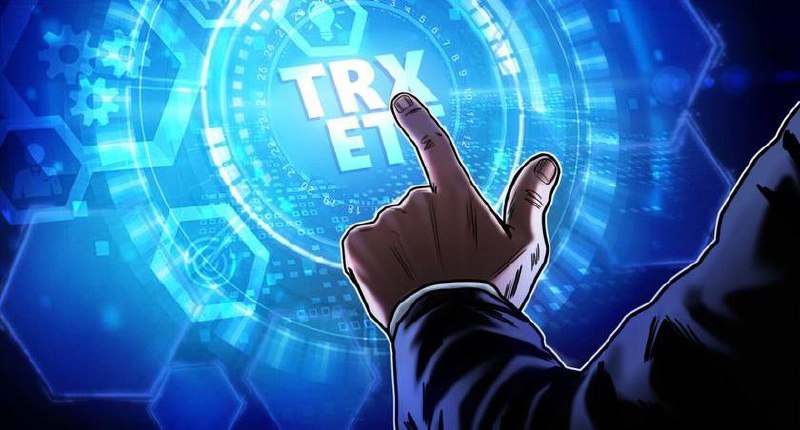
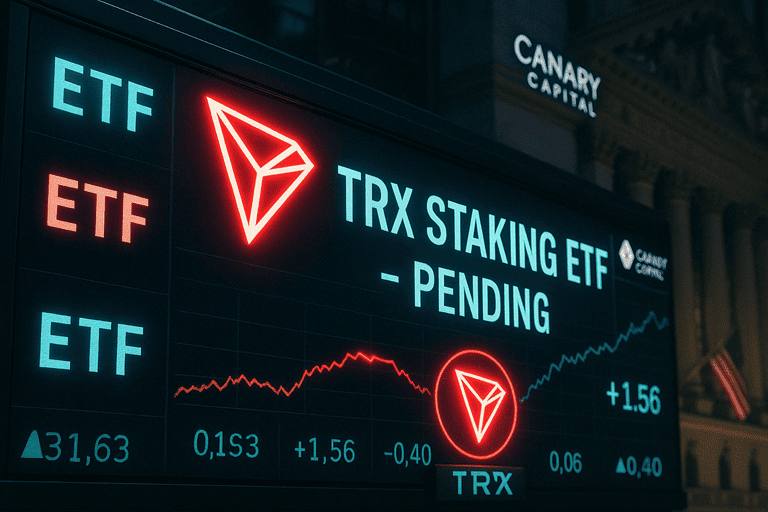
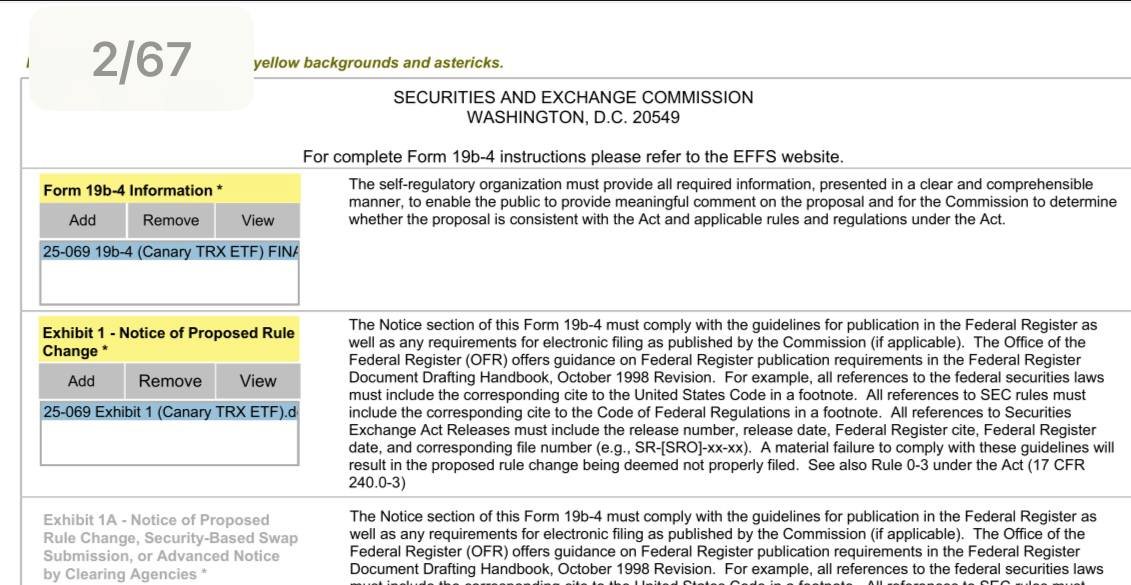

81,34 tn
26
DOT-kalkylator


Polkadot prisutveckling i USD
Aktuellt pris på Polkadot är $4,7790. Sedan 00.00 UTC har Polkadot ökade med +3,60 %. Det har för närvarande ett cirkulerande utbud av 1 522 267 060 DOT och ett maximalt utbud av 1 522 267 060 DOT, vilket ger ett marknadsvärde efter full utspädning på $7,27B. För tillfället innehar Polkadot-coin position 0 i marknadsvärdesrankningar. Polkadot/USD-priset uppdateras i realtid.
Idag
+$0,16600
+3,59 %
7 dagar
-$0,31100
−6,12 %
30 dagar
+$1,0730
+28,95 %
3 månader
-$0,11100
−2,27 %
Populära Polkadot-omvandlingar
Senast uppdaterad: 2025-05-18 19:35
| 1 DOT till USD | 4,7730 $ |
| 1 DOT till EUR | 4,2761 € |
| 1 DOT till PHP | 266,35 ₱ |
| 1 DOT till IDR | 78 723,40 Rp |
| 1 DOT till GBP | 3,5933 £ |
| 1 DOT till CAD | 6,6681 $ |
| 1 DOT till AED | 17,5312 AED |
| 1 DOT till VND | 123 717,0 ₫ |
Om Polkadot (DOT)
Betyget som anges är ett sammanställt betyg som inhämtats av OKX från källorna som anges, och det anges endast för informativa syften. OKX garanterar inte betygens kvalitet eller korrekthet. Det är inte avsett att utgöra (i) investeringsrådgivning eller rekommendation, (ii) ett erbjudande eller en uppmaning att köpa, sälja eller inneha digitala tillgångar, eller (iii) finansiell, redovisningsmässig, juridisk eller skattemässig rådgivning. Digitala tillgångar, inklusive stabil kryptovaluta och NFT:er, omfattas av hög risk, kan skifta kraftigt och till och med bli värdelösa. Priset och prestanda för de digitala tillgångarna garanteras inte, och de kan förändras utan föregående meddelande. Dina digitala tillgångar täcks inte av försäkran mot potentiella förluster. Historisk avkastning är ingen garanti om framtida avkastning. OKX garanterar inte någon avkastning, återbetalning av huvudbelopp eller ränta. OKX tillhandahåller inga rekommendationer om investeringar eller tillgångar. Du bör noga överväga om handel med eller innehav av digitala tillgångar är lämpligt för dig med hänsyn till din ekonomiska situation. Rådgör med din jurist, skatteexpert eller investeringsrådgivare om du har frågor om dina specifika omständigheter.
Visa mer
- Officiell webbplats
- Vitbok
- Github
- Block explorer
Om tredjeparts webbplatser
Om tredjeparts webbplatser
Genom att använda tredjepartswebbplatsen (”TPW”) samtycker du till att all användning av TPW kommer att omfattas av och styras av villkoren i TPW. Om inte annat uttryckligen anges skriftligen är OKX och dess affiliates (”OKX”) inte på något sätt associerade med ägaren eller operatören av TPW. Du samtycker till att OKX inte är ansvarigt eller skadeståndsskyldigt för förlust, skada eller andra konsekvenser som uppstår till följd av din användning av TPW. Var medveten om att användning av en TPW kan leda till förlust eller minskning av dina tillgångar.
Vanliga frågor för Polkadot
Hur mycket är 1 Polkadot värd idag?
För närvarande är en Polkadot värd $4,7790. För svar och insikt om prisåtgärder för Polkadot är du på rätt plats. Utforska de senaste diagrammen för Polkadot och handla ansvarsfullt med OKX.
Vad är kryptovalutor?
Kryptovalutor, till exempel Polkadot, är digitala tillgångar som fungerar på en offentlig reskontra som kallas blockkedjor. Läs mer om coins och tokens som erbjuds på OKX och deras olika attribut, som inkluderar live-priser och realtidsdiagram.
När uppfanns kryptovalutor?
Tack vare finanskrisen 2008 ökade intresset för decentraliserad finansiering. Bitcoin erbjöd en ny lösning genom att vara en säker digital tillgång på ett decentraliserat nätverk. Sedan dess har många andra tokens som t.ex. Polkadot skapats också.
Kommer priset på Polkadot gå upp idag?
Se vår Polkadot prisprognossida för att förutse framtida priser och fastställa dina prismål.
ESG-upplysning
ESG-regleringar (Environmental, Social och Governance) för kryptotillgångar syftar till att ta itu med eventuell miljöpåverkan (t.ex. energiintensiv mining), främja transparens och säkerställa etiska förvaltningsmetoder för att anpassa kryptoindustrin till bredare hållbarhets- och samhälleliga mål. Dessa regleringar uppmuntrar efterlevnad av standarder som minskar risker och främjar förtroende för digitala tillgångar.
Tillgångsdetaljer
Namn
OKcoin Europe LTD
Relevant juridisk enhetsidentifierare
54930069NLWEIGLHXU42
Namn på kryptotillgången
Polkadot DOT
Konsensusmekanism
Polkadot DOT is present on the following networks: binance_smart_chain, huobi, polkadot.
Binance Smart Chain (BSC) uses a hybrid consensus mechanism called Proof of Staked Authority (PoSA), which combines elements of Delegated Proof of Stake (DPoS) and Proof of Authority (PoA). This method ensures fast block times and low fees while maintaining a level of decentralization and security. Core Components 1. Validators (so-called “Cabinet Members”): Validators on BSC are responsible for producing new blocks, validating transactions, and maintaining the network’s security. To become a validator, an entity must stake a significant amount of BNB (Binance Coin). Validators are selected through staking and voting by token holders. There are 21 active validators at any given time, rotating to ensure decentralization and security. 2. Delegators: Token holders who do not wish to run validator nodes can delegate their BNB tokens to validators. This delegation helps validators increase their stake and improves their chances of being selected to produce blocks. Delegators earn a share of the rewards that validators receive, incentivizing broad participation in network security. 3. Candidates: Candidates are nodes that have staked the required amount of BNB and are in the pool waiting to become validators. They are essentially potential validators who are not currently active but can be elected to the validator set through community voting. Candidates play a crucial role in ensuring there is always a sufficient pool of nodes ready to take on validation tasks, thus maintaining network resilience and decentralization. Consensus Process 4. Validator Selection: Validators are chosen based on the amount of BNB staked and votes received from delegators. The more BNB staked and votes received, the higher the chance of being selected to validate transactions and produce new blocks. The selection process involves both the current validators and the pool of candidates, ensuring a dynamic and secure rotation of nodes. 5. Block Production: The selected validators take turns producing blocks in a PoA-like manner, ensuring that blocks are generated quickly and efficiently. Validators validate transactions, add them to new blocks, and broadcast these blocks to the network. 6. Transaction Finality: BSC achieves fast block times of around 3 seconds and quick transaction finality. This is achieved through the efficient PoSA mechanism that allows validators to rapidly reach consensus. Security and Economic Incentives 7. Staking: Validators are required to stake a substantial amount of BNB, which acts as collateral to ensure their honest behavior. This staked amount can be slashed if validators act maliciously. Staking incentivizes validators to act in the network's best interest to avoid losing their staked BNB. 8. Delegation and Rewards: Delegators earn rewards proportional to their stake in validators. This incentivizes them to choose reliable validators and participate in the network’s security. Validators and delegators share transaction fees as rewards, which provides continuous economic incentives to maintain network security and performance. 9. Transaction Fees: BSC employs low transaction fees, paid in BNB, making it cost-effective for users. These fees are collected by validators as part of their rewards, further incentivizing them to validate transactions accurately and efficiently.
The Huobi Eco Chain (HECO) blockchain employs a Hybrid-Proof-of-Stake (HPoS) consensus mechanism, combining elements of Proof-of-Stake (PoS) to enhance transaction efficiency and scalability. Key Features of HECO's Consensus Mechanism: 1. Validator Selection: HECO supports up to 21 validators, selected based on their stake in the network. 2. Transaction Processing: Validators are responsible for processing transactions and adding blocks to the blockchain. 3. Transaction Finality: The consensus mechanism ensures quick finality, allowing for rapid confirmation of transactions. 4. Energy Efficiency: By utilizing PoS elements, HECO reduces energy consumption compared to traditional Proof-of-Work systems.
Polkadot, a heterogeneous multi-chain framework designed to enable different blockchains to interoperate, uses a sophisticated consensus mechanism known as Nominated Proof-of-Stake (NPoS). This mechanism combines elements of Proof-of-Stake (PoS) and a layered consensus model involving multiple roles and stages. Core Components 1. Validators: Validators are responsible for producing new blocks and finalizing the relay chain, Polkadot's main chain. They stake DOT tokens and validate transactions, ensuring the security and integrity of the network. 2. Nominators: Nominators delegate their stake to trusted validators, choosing which validators they believe will act honestly and effectively. They share in the rewards and penalties of the validators they nominate. 3. Collators: Collators maintain parachains (individual blockchains that connect to the Polkadot relay chain) by collecting transactions from users and producing state transition proofs for validators. 4. Fishermen: Fishermen monitor the network for malicious activity. They report bad behavior to the validators to help maintain network security. Consensus Process Polkadot's consensus mechanism operates through a combination of two key protocols: GRANDPA (GHOST-based Recursive Ancestor Deriving Prefix Agreement) and BABE (Blind Assignment for Blockchain Extension). 1. BABE (Block Production): BABE is the block production mechanism. It operates similarly to a lottery, where validators are pseudo-randomly assigned slots to produce blocks based on their stake. Each validator signs the blocks they produce, which are then propagated through the network. 2. GRANDPA (Finality): GRANDPA is the finality gadget that provides a higher level of security by finalizing blocks after they are produced. Unlike traditional blockchains where blocks are considered final after a number of confirmations, GRANDPA allows for asynchronous finality. Validators vote on chains, and once a supermajority agrees, the chain is finalized instantly. Detailed Steps 1. Block Production (BABE): Slot Allocation: Validators are selected to produce blocks in specific time slots. Block Proposal: The selected validator for a slot proposes a block, including new transactions and state changes. 2. Block Propagation and Preliminary Consensus: Proposed blocks are propagated across the network, where other validators verify the correctness of the transactions and state transitions. 3. Finalization (GRANDPA): Voting on Blocks: Validators vote on the chains they believe to be the correct history. Supermajority Agreement: Once more than two-thirds of validators agree on a block, it is finalized. Instant Finality: This finality process ensures that once a block is finalized, it is irreversible and becomes part of the canonical chain. 4. Rewards and Penalties: Validators and nominators earn rewards for participating in the consensus process and maintaining network security. Misbehavior, such as producing invalid blocks or being offline, results in penalties, including slashing of staked tokens.
Incitamentmekanismer och tillämpliga avgifter
Polkadot DOT is present on the following networks: binance_smart_chain, huobi, polkadot.
Binance Smart Chain (BSC) uses the Proof of Staked Authority (PoSA) consensus mechanism to ensure network security and incentivize participation from validators and delegators. Incentive Mechanisms 1. Validators: Staking Rewards: Validators must stake a significant amount of BNB to participate in the consensus process. They earn rewards in the form of transaction fees and block rewards. Selection Process: Validators are selected based on the amount of BNB staked and the votes received from delegators. The more BNB staked and votes received, the higher the chances of being selected to validate transactions and produce new blocks. 2. Delegators: Delegated Staking: Token holders can delegate their BNB to validators. This delegation increases the validator's total stake and improves their chances of being selected to produce blocks. Shared Rewards: Delegators earn a portion of the rewards that validators receive. This incentivizes token holders to participate in the network’s security and decentralization by choosing reliable validators. 3. Candidates: Pool of Potential Validators: Candidates are nodes that have staked the required amount of BNB and are waiting to become active validators. They ensure that there is always a sufficient pool of nodes ready to take on validation tasks, maintaining network resilience. 4. Economic Security: Slashing: Validators can be penalized for malicious behavior or failure to perform their duties. Penalties include slashing a portion of their staked tokens, ensuring that validators act in the best interest of the network. Opportunity Cost: Staking requires validators and delegators to lock up their BNB tokens, providing an economic incentive to act honestly to avoid losing their staked assets. Fees on the Binance Smart Chain 5. Transaction Fees: Low Fees: BSC is known for its low transaction fees compared to other blockchain networks. These fees are paid in BNB and are essential for maintaining network operations and compensating validators. Dynamic Fee Structure: Transaction fees can vary based on network congestion and the complexity of the transactions. However, BSC ensures that fees remain significantly lower than those on the Ethereum mainnet. 6. Block Rewards: Incentivizing Validators: Validators earn block rewards in addition to transaction fees. These rewards are distributed to validators for their role in maintaining the network and processing transactions. 7. Cross-Chain Fees: Interoperability Costs: BSC supports cross-chain compatibility, allowing assets to be transferred between Binance Chain and Binance Smart Chain. These cross-chain operations incur minimal fees, facilitating seamless asset transfers and improving user experience. 8. Smart Contract Fees: Deployment and Execution Costs: Deploying and interacting with smart contracts on BSC involves paying fees based on the computational resources required. These fees are also paid in BNB and are designed to be cost-effective, encouraging developers to build on the BSC platform.
The Huobi Eco Chain (HECO) blockchain employs a Hybrid-Proof-of-Stake (HPoS) consensus mechanism, combining elements of Proof-of-Stake (PoS) to enhance transaction efficiency and scalability. Incentive Mechanism: 1. Validator Rewards: Validators are selected based on their stake in the network. They process transactions and add blocks to the blockchain. Validators receive rewards in the form of transaction fees for their role in maintaining the blockchain's integrity. 2. Staking Participation: Users can stake Huobi Token (HT) to become validators or delegate their tokens to existing validators. Staking helps secure the network and, in return, participants receive a portion of the transaction fees as rewards. Applicable Fees: 1. Transaction Fees (Gas Fees): Users pay gas fees in HT tokens to execute transactions and interact with smart contracts on the HECO network. These fees compensate validators for processing and validating transactions. 2. Smart Contract Execution Fees: Deploying and interacting with smart contracts incur additional fees, which are also paid in HT tokens. These fees cover the computational resources required to execute contract code.
Polkadot uses a consensus mechanism called Nominated Proof-of-Stake (NPoS), which involves a combination of validators, nominators, and a unique layered consensus process to secure the network: Incentive Mechanisms 1. Validators: Staking Rewards: Validators are responsible for producing new blocks and finalizing the relay chain. They are incentivized with staking rewards, which are distributed in proportion to their stake and their performance in the consensus process. Validators earn these rewards for maintaining uptime and correctly validating transactions. Commission: Validators can set a commission rate that they charge on the rewards earned by their nominators. This incentivizes them to perform well to attract more nominators. 2. Nominators: Delegation: Nominators stake their tokens by delegating them to trusted validators. They share in the rewards earned by the validators they support. This mechanism incentivizes nominators to carefully choose reliable validators. Rewards Distribution: The rewards are distributed among validators and their nominators based on the amount of stake contributed by each party. This ensures that both parties are incentivized to maintain the network’s security. 3. Collators: Parachain Maintenance: Collators maintain parachains by collecting transactions and producing state transition proofs for validators. They are incentivized through rewards for their role in keeping the parachain operational and secure. 4. Fishermen: Monitoring: Fishermen are responsible for monitoring the network for malicious activities. They are rewarded for identifying and reporting malicious behavior, which helps maintain the network’s security. 5. Economic Penalties: Slashing: Validators and nominators face penalties in the form of slashing if they engage in malicious activities such as double-signing or being offline for extended periods. Slashing results in the loss of a portion of their staked tokens, which serves as a strong deterrent against bad behavior. Unbonding Period: To withdraw staked tokens, participants must go through an unbonding period during which their tokens are still at risk of being slashed. This ensures continued network security even when validators or nominators decide to exit. Fees on the Polkadot Blockchain 1. Transaction Fees: Dynamic Fees: Transaction fees on Polkadot are dynamic, adjusting based on network demand and the complexity of the transaction. This model ensures that fees remain fair and proportional to the network’s usage. Fee Burn: A portion of the transaction fees is burned (permanently removed from circulation), which helps to control inflation and can potentially increase the value of the remaining tokens. 2. Smart Contract Fees: Execution Costs: Fees for deploying and interacting with smart contracts on Polkadot are based on the computational resources required. This encourages efficient use of network resources. 3. Parachain Slot Auction Fees: Bidding for Slots: Projects that want to secure a parachain slot must participate in a slot auction. They bid DOT tokens, and the highest bidders win the right to operate a parachain for a specified period. This process ensures that only serious projects with significant backing can secure parachain slots, contributing to the network's overall quality and security.
Början av den period som upplysningen avser
2024-04-20
Slutet av den period som upplysningen avser
2025-04-20
Energirapport
Energiförbrukning
630787.02246 (kWh/a)
Förnybar energiförbrukning
18.621866628 (%)
Energiintensitet
0.00029 (kWh)
Viktiga energikällor och metoder
To determine the proportion of renewable energy usage, the locations of the nodes are to be determined using public information sites, open-source crawlers and crawlers developed in-house. If no information is available on the geographic distribution of the nodes, reference networks are used which are comparable in terms of their incentivization structure and consensus mechanism. This geo-information is merged with public information from the European Environment Agency (EEA) and thus determined. The intensity is calculated as the marginal energy cost wrt. one more transaction.
Energiförbrukningskällor och -metoder
The energy consumption of this asset is aggregated across multiple components:
For the calculation of energy consumptions, the so called “bottom-up” approach is being used. The nodes are considered to be the central factor for the energy consumption of the network. These assumptions are made on the basis of empirical findings through the use of public information sites, open-source crawlers and crawlers developed in-house. The main determinants for estimating the hardware used within the network are the requirements for operating the client software. The energy consumption of the hardware devices was measured in certified test laboratories. When calculating the energy consumption, we used - if available - the Functionally Fungible Group Digital Token Identifier (FFG DTI) to determine all implementations of the asset of question in scope and we update the mappings regulary, based on data of the Digital Token Identifier Foundation.
To determine the energy consumption of a token, the energy consumption of the network(s) binance_smart_chain, huobi is calculated first. Based on the crypto asset's gas consumption per network, the share of the total consumption of the respective network that is assigned to this asset is defined. When calculating the energy consumption, we used - if available - the Functionally Fungible Group Digital Token Identifier (FFG DTI) to determine all implementations of the asset of question in scope and we update the mappings regulary, based on data of the Digital Token Identifier Foundation.
Utsläppsrapport
Omfattning 1 DLT växthusgasintensitet-utsläpp – Kontrollerade
0.00000 (tCO2e/a)
Omfattning 2 DLT växthusgasintensitet-utsläpp – Köpt
186.16899 (tCO2e/a)
Växthusgasintensitet
0.00008 (kgCO2e)
Viktiga växthusgasintensitets-källor och -metoder
To determine the proportion of renewable energy usage, the locations of the nodes are to be determined using public information sites, open-source crawlers and crawlers developed in-house. If no information is available on the geographic distribution of the nodes, reference networks are used which are comparable in terms of their incentivization structure and consensus mechanism. This geo-information is merged with public information from the European Environment Agency (EEA) and thus determined. The intensity is calculated as the marginal emission wrt. one more transaction.
DOT-kalkylator















Sociala medier